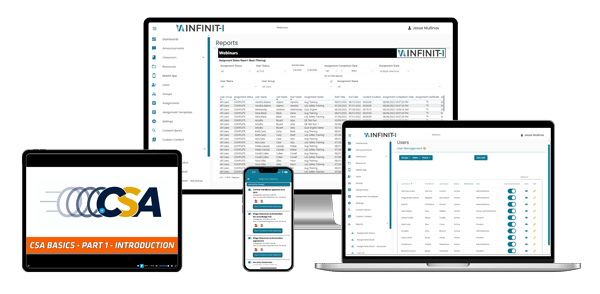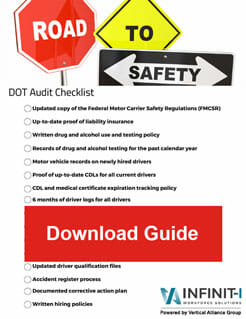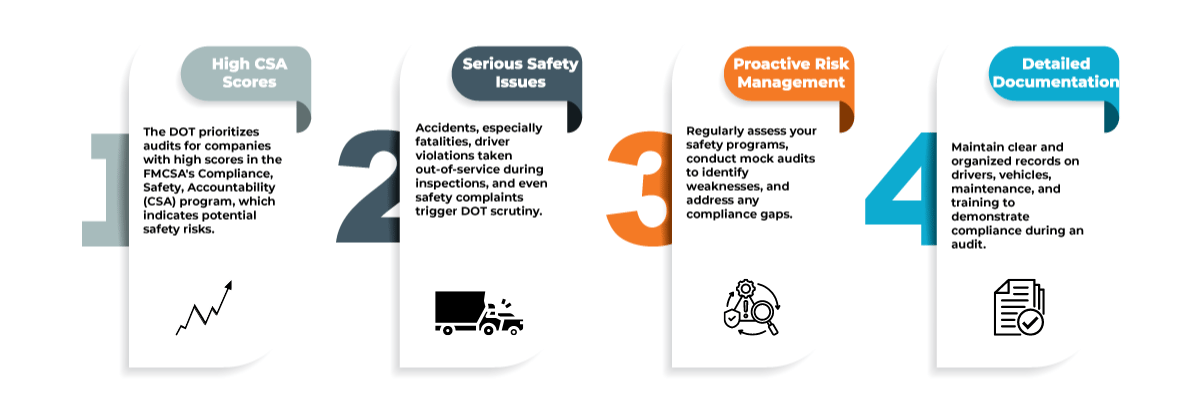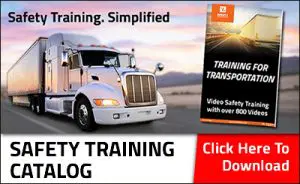WHAT TRIGGERS A DOT COMPLIANCE AUDIT?
What Triggers a DOT Compliance Audit?
When it comes to a DOT compliance audit, it’s not a matter of “if”, it’s a matter of “when”. An audit is triggered after an accident or poor review during a roadside stop. These audits can also be triggered by bad CSA scores for a company.
during a roadside stop. These audits can also be triggered by bad CSA scores for a company.
On top of these issues that can trigger an audit, the DOT does do random audits at times, so you will find yourself going through a compliance audit if you work in the trucking industry. When the auditor comes, you need to be ready with proper documentation.
Remember, if it’s not documented, dated, and readily available, it didn’t happen.
How does the DOT oversee trucking firms?
The Department of Transportation (DOT) is a federal regulatory agency that oversees all transportation in the United States. The Federal Motor Carrier Safety Administration (FMCSA) is a division of the DOT tasked with regulating the commercial vehicle industry.
The FMCSA develops and enforces regulations meant to keep the roadways and truck drivers safe. All trucking companies and drivers must follow all FMCSA regulations or face penalties such as fees or having their trucks taken off the road.
The Department of Transportation (DOT) conducts audits to ensure trucking companies comply with safety regulations. Here’s what can trigger an audit:
- High CSA Scores: The FMCSA’s CSA program assigns safety ratings. High scores in areas like crashes, driver violations, or vehicle maintenance raise red flags.
- Serious Accidents: Accidents, especially those with fatalities, will get the DOT’s attention.
- Roadside Violations: Drivers placed out-of-service during inspections increase the company’s audit risk.
- Safety Complaints: Even complaints from disgruntled employees are taken seriously by the FMCSA.
- Random Audits: The DOT also conducts random audits to ensure overall compliance.
Here are some tips to avoid a DOT audit:
- Regularly assess your safety programs and identify areas for improvement.
- Conduct mock audits to identify weaknesses in your compliance procedures.
- Ensure you have proper documentation readily available for the auditors.
- Use a DOT Compliance Checklist to help make sure all audit items are checked regular.
WHAT DO YOU NEED DURING A DOT AUDIT?
When an auditor comes, it’s important to have all the necessary documentation ready, including driver logs, medical records, and safety training  records. This documentation could mean the difference between a simple audit and getting your trucks parked.
records. This documentation could mean the difference between a simple audit and getting your trucks parked.
One of the most important things an auditor looks for is your company’s safety record. They want to see how you’re implementing driver safety training programs, and more importantly how well they are working.
They will also look at your company policies. They want to make sure all company personnel have read and are following these policies. It’s important to make sure all your documentation can prove consistent efforts towards maintaining a culture of safety.
 The Consequences of a Bad Audit
The Consequences of a Bad Audit
If your DOT compliance review audit doesn’t show sufficient training and safety documentation, you could end up with a Conditional status, meaning the auditor provides an action plan and a deadline for you to implement it.
Conditional status can put a target on your company. Your trucks will get stopped more often and will be subjected to more frequent roadside inspections. You’ll also find it difficult to find clients and drivers willing to work with your company if you have a conditional status.
Without the right tools in place, you could end up costing your company time and money.
Protecting Your Company During an Audit
The best way to make sure you have all your documentation ready for an audit is to implement an online DOT safety training program like Infinti-I Workforce Solutions. The Infinit-I system is easy for drivers to use and makes maintaining and accessing records easy for you.
The cloud-based solution allows drivers to complete ongoing short, interactive courses, and maintains all records of participation and testing scores with date and timestamps. This means when DOT comes calling for an audit, you have all the documentation you need to keep your trucks on the road and in good standing.
Infint-I can help you solve your biggest safety training issues, all while saving your company money. For more information about how, download our Trucking Insurance Whitepaper.
Prepare Against Your Next DOT Compliance Audit
A DOT compliance audit is almost inevitable for trucking companies, triggered by accidents, poor roadside reviews, bad CSA scores, or even random selection by the DOT. During an audit, having proper documentation readily available is crucial. If it’s not documented and easily accessible, it’s as if it didn’t happen. Here’s how you can navigate DOT audits effectively:
- High CSA Scores: Red flags are raised by high scores in crashes, driver violations, or vehicle maintenance.
- Serious Accidents: Fatal accidents especially draw the DOT’s attention.
- Roadside Violations: Out-of-service incidents during inspections increase audit risks.
- Safety Complaints: Even employee complaints are taken seriously by the FMCSA.
- Random Audits: The DOT conducts random audits to ensure overall compliance.
To avoid audits or mitigate their impact:
- Regularly assess safety programs for improvement.
- Conduct mock audits to identify compliance weaknesses.
- Ensure all required documentation is readily available for auditors.
Infinit-I is Here for Your Company
Your company could be subject to a DOT compliance audit at any time, but especially after incidents on the road. A culture of safety goes a long way towards passing these audits, and that’s where Infinit-I Workforce Solutions is on your side.
A trucking company Ram Services and one of our clients with a good safety record except for 2 accidents faced a DOT audit downgrade due to the accidents. However, because they had well documented training records and accident countermeasure plans, they were able to appeal the downgrade and get their rating back to satisfactory quickly. Read more on how Ram Services empowered their DOT Audits.
Before you take your chances with your next audit, check out how Infinit-I can help you create a program to meet your safety and compliance needs. To see it for yourself, request a demo today.
Learn why Over 1,500 Companies Trust Infinit-I for DOT Safety Training
FAQs
What triggers a DOT compliance audit?
A DOT compliance audit can be triggered by serious accidents, high CSA scores, roadside violations, safety complaints, or even random selection by the DOT.
What is the role of the DOT and FMCSA?
The Department of Transportation (DOT) oversees all transportation in the United States. The Federal Motor Carrier Safety Administration (FMCSA) is a division of the DOT tasked with regulating the commercial vehicle industry.
What documentation is needed during a DOT audit?
Necessary documentation includes driver logs, medical records, safety training records, and proof of consistent efforts towards maintaining a culture of safety.
What are the consequences of a bad audit?
If your DOT compliance audit doesn’t show sufficient training and safety documentation, you could end up with a Conditional status. This could lead to more frequent roadside inspections, difficulty finding clients, and difficulty recruiting drivers.
How can I prepare for a DOT compliance audit?
Regularly assess your safety programs for improvement, conduct mock audits to identify compliance weaknesses, and ensure all required documentation is readily available for auditors.
What is the role of CSA scores in a DOT audit?
The FMCSA’s CSA program assigns safety ratings. High scores in areas like crashes, driver violations, or vehicle maintenance raise red flags and can trigger an audit.
How does the DOT respond to serious accidents?
Accidents, especially those with fatalities, will get the DOT’s attention and can trigger an audit.
What impact do roadside violations have on a DOT audit?
Drivers placed out-of-service during inspections increase the company’s audit risk.
How seriously does the FMCSA take safety complaints?
Even complaints from disgruntled employees are taken seriously by the FMCSA and can trigger an audit.
What role do random audits play in DOT compliance?
The DOT conducts random audits to ensure overall compliance, so even if there are no red flags, a company can still be audited.
What happens if you fail a dot audit?
If your DOT compliance audit doesn’t show sufficient training and safety documentation, you could end up with a Conditional status. This status means the auditor provides an action plan and a deadline for you to implement it. Being in Conditional status can put a target on your company, leading to more frequent roadside inspections and difficulties in finding clients and drivers willing to work with your company.
What is a dot audit?
A DOT audit is a process conducted by the Department of Transportation (DOT) to ensure that trucking companies are complying with safety regulations. These audits are triggered by various factors such as high CSA scores assigned by the FMCSA’s CSA program, serious accidents especially those involving fatalities, roadside violations that result in drivers being placed out-of-service during inspections, safety complaints from employees, and also through random selection by the DOT. During an audit, it is crucial to have proper documentation readily available.



















